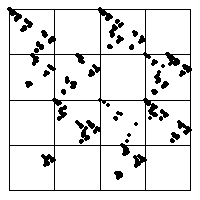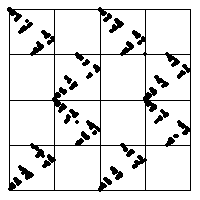| Logistic |
| 0.9, 0.99 |
| 1.5, 1.5 |
| 2.4, 2.9 |
| 3.1, 3.5 |
| 3.55, 3.57 |
| 3.6, 3.7 |
| 3.8, 3.825 |
| 3.826, 3.827 |
| 3.828, 3.829 |
| 3.846, 3.999 |
| Tent |
| 1.2, 1.32 |
| 1.4, 1.5 |
| 1.7, 1.8 |
| 1.9, 1.999 |
|
 |
 |
s = 1.9. The diagram continues to unfold. More combinations of bins occur,
but note that although square 11 is occupied (two successive iterates can fall in bin 1),
square 44 is not occupied. |
s = 1.999. Fully developed chaos, yet with a clear pattern of forbidden combinations. These
are some of the most effective situations in which to use driven IFS, to distinguish chaos from
randomness. |
|

